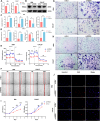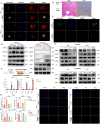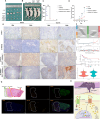The enhanced energy metabolism in the tumor margin mediated by RRAD promotes the progression of oral squamous cell carcinoma
- PMID: 38811531
- PMCID: PMC11137138
- DOI: 10.1038/s41419-024-06759-7
The enhanced energy metabolism in the tumor margin mediated by RRAD promotes the progression of oral squamous cell carcinoma
Abstract
The tumor margin as the invasive front has been proven to be closely related to the progression and metastasis of oral squamous cell carcinoma (OSCC). However, how tumor cells in the marginal region obtain the extra energy needed for tumor progression is still unknown. Here, we used spatial metabolomics and the spatial transcriptome to identify enhanced energy metabolism in the tumor margin of OSCC and identified that the downregulation of Ras-related glycolysis inhibitor and calcium channel regulator (RRAD) in tumor cells mediated this process. The absence of RRAD enhanced the ingestion of glucose and malignant behaviors of tumor cells both in vivo and in vitro. Mechanically, the downregulation of RRAD promoted the internal flow of Ca2+ and elevated its concentration in the nucleus, which resulted in the activation of the CAMKIV-CREB1 axis to induce the transcription of the glucose transporter GLUT3. GLUT inhibitor-1, as an inhibitor of GLUT3, could suppress this vigorous energy metabolism and malignant behaviors caused by the downregulation of RRAD. Taken together, our study revealed that enhanced energy metabolism in the tumor margin mediated by RRAD promotes the progression of OSCC and proved that GLUT3 is a potential target for future treatment of OSCC.
© 2024. The Author(s).
Conflict of interest statement
The authors declare no competing interests.
Figures






Similar articles
-
FAM83A Promotes the Progression and Metastasis of Head and Neck Squamous Cell Carcinoma via PKM2-Mediated Aerobic Glycolysis.FASEB J. 2025 Jul 31;39(14):e70796. doi: 10.1096/fj.202500989RR. FASEB J. 2025. PMID: 40637278
-
IER3 Facilitates Tumor Progression and Aberrant Glycolysis via Activating wnt/β-Catenin Pathway in Oral Squamous Cell Carcinoma.Adv Biol (Weinh). 2025 Jul;9(7):e2400564. doi: 10.1002/adbi.202400564. Epub 2025 Mar 24. Adv Biol (Weinh). 2025. PMID: 40128149
-
N6-methyladenosine (m6A) reader IGF2BP2 stabilizes HK2 stability to accelerate the Warburg effect of oral squamous cell carcinoma progression.J Cancer Res Clin Oncol. 2022 Dec;148(12):3375-3384. doi: 10.1007/s00432-022-04093-z. Epub 2022 Jun 28. J Cancer Res Clin Oncol. 2022. PMID: 35763110 Free PMC article.
-
The Role of Glucose Transporters in Oral Squamous Cell Carcinoma.Biomolecules. 2021 Jul 21;11(8):1070. doi: 10.3390/biom11081070. Biomolecules. 2021. PMID: 34439735 Free PMC article.
-
Sun protection for preventing basal cell and squamous cell skin cancers.Cochrane Database Syst Rev. 2016 Jul 25;7(7):CD011161. doi: 10.1002/14651858.CD011161.pub2. Cochrane Database Syst Rev. 2016. PMID: 27455163 Free PMC article.
Cited by
-
In Vivo Visualization of Tumor Metabolic Activity with a Tetra Glucose-Conjugated Zinc-Phthalocyanine Photoacoustic Contrast.JACS Au. 2025 May 20;5(6):2542-2555. doi: 10.1021/jacsau.5c00151. eCollection 2025 Jun 23. JACS Au. 2025. PMID: 40575291 Free PMC article.
-
HAS1high cancer associated fibroblasts located at the tumor invasion front zone promote oral squamous cell carcinoma invasion via ECM remodeling.J Exp Clin Cancer Res. 2025 Aug 14;44(1):238. doi: 10.1186/s13046-025-03493-6. J Exp Clin Cancer Res. 2025. PMID: 40813707 Free PMC article.
-
The regulatory role and mechanism of energy metabolism and immune response in head and neck cancer.Genes Dis. 2025 Mar 19;12(6):101607. doi: 10.1016/j.gendis.2025.101607. eCollection 2025 Nov. Genes Dis. 2025. PMID: 40821122 Free PMC article. Review.
-
Spatial and Single-Cell Analyses Reveal Heterogeneity of DNAM-1 Receptor-Ligand Interactions That Instructs Intratumoral γδT-cell Activity.Cancer Res. 2025 Jan 15;85(2):277-298. doi: 10.1158/0008-5472.CAN-24-1509. Cancer Res. 2025. PMID: 39514370 Free PMC article.
-
Advances in spatial transcriptomics and its applications in cancer research.Mol Cancer. 2024 Jun 20;23(1):129. doi: 10.1186/s12943-024-02040-9. Mol Cancer. 2024. PMID: 38902727 Free PMC article. Review.
References
-
- He JZ, Chen Y, Zeng FM, Huang QF, Zhang HF, Wang SH. Spatial analysis of stromal signatures identifies invasive front carcinoma-associated fibroblasts as suppressors of anti-tumor immune response in esophageal cancer. J Exp Clin Cancer Res. 2023;42:136. doi: 10.1186/s13046-023-02697-y. - DOI - PMC - PubMed
Publication types
MeSH terms
Substances
Grants and funding
LinkOut - more resources
Full Text Sources
Medical
Miscellaneous

